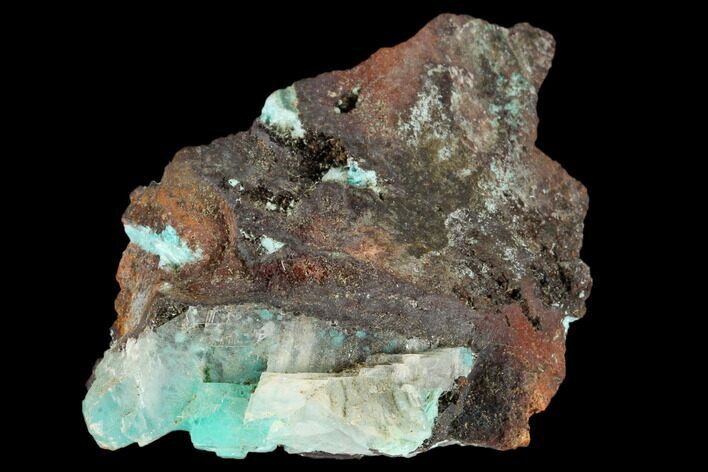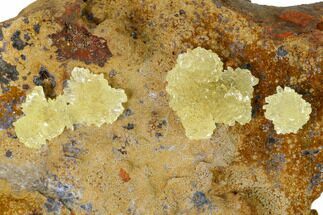This Specimen has been sold.
1.8" Aurichalcite Included Calcite Crystals - Mexico
This colorful specimen contains blue-green, fibrous aurichalcite crystals that grew prior to the formation of calcite crystals. Along one edge of the specimen, the fibrous aurichalcite crystals can be found included within these calcite crystals. This beautiful specimen was collected from the Ojuela Mine in Durango, Mexico. These crystals formed from a bright orange limonitic matrix.
Aurichalcite (chemical formula (Zn,Cu)5(CO3)2(OH)6) is a secondary mineral that forms in the oxidation zones of copper and zinc ore deposits. It often forms as radiating, fuzzy-looking acicular blue-green crystals and linings along cavity walls.
About Calcite Crystals
Calcite crystals are a form of calcium carbonate (CaCO₃) known for their diverse shapes, transparency, and vibrant range of colors. They typically form in rhombohedral, scalenohedral, or prismatic shapes, often with well-defined, sharp edges and glossy surfaces. Calcite crystals are often translucent or transparent, sometimes displaying a double refraction effect where objects viewed through the crystal appear doubled. They can appear in various colors—white, clear, yellow, pink, blue, green, and orange—depending on impurities or trace minerals.
A notable characteristic of calcite is its reaction with weak acids like vinegar, which causes it to effervesce, or fizz, as it releases carbon dioxide. This property makes calcite crystals a key tool in geological identification and studies. Calcite forms in many environments, from sedimentary rocks like limestone and marble to hydrothermal veins.
Calcite crystals are a form of calcium carbonate (CaCO₃) known for their diverse shapes, transparency, and vibrant range of colors. They typically form in rhombohedral, scalenohedral, or prismatic shapes, often with well-defined, sharp edges and glossy surfaces. Calcite crystals are often translucent or transparent, sometimes displaying a double refraction effect where objects viewed through the crystal appear doubled. They can appear in various colors—white, clear, yellow, pink, blue, green, and orange—depending on impurities or trace minerals.
A notable characteristic of calcite is its reaction with weak acids like vinegar, which causes it to effervesce, or fizz, as it releases carbon dioxide. This property makes calcite crystals a key tool in geological identification and studies. Calcite forms in many environments, from sedimentary rocks like limestone and marble to hydrothermal veins.
SPECIES
Aurichalcite & Calcite
LOCATION
Ojuela Mine, Mapimi, Durango, Mexico.
SIZE
1.8 x 1.2"
CATEGORY
ITEM
#119177
 Reviews
Reviews













